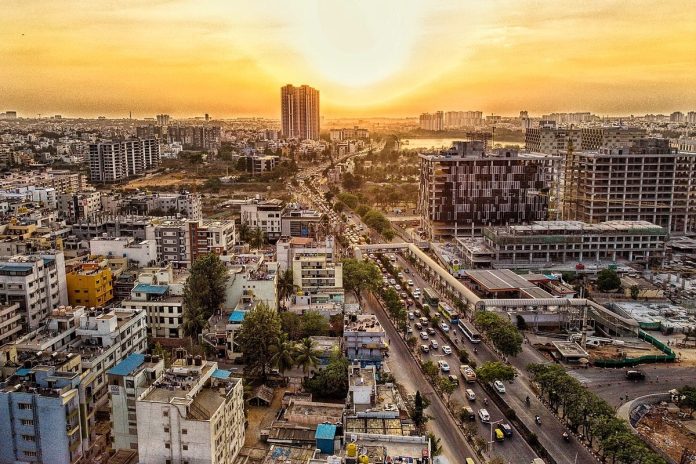As the metro extends its reach across numerous Indian cities, its expansive network now presents an opportunity to look further on supporting the transit system, within the larger framework of development and overall connectivity.
In order to align with ambitions of the urban future, it is time to shift the perspective from viewing the metro in isolation, and focusing on integrating transportation and economic progress, as well as enhancing liveability through this infrastructure.
This integration, particularly in terms of connectivity, involves facilitating diverse options of accessing the corridor and addressing last-mile connectivity challenges.
Simultaneously, the principles of transit-oriented development also gain relevance for future growth of the cities, as the corridor influence real estate, land use and commerce.
This urgency arises as major Indian cities are heavily invested in creating its metro networks for public transit, that aims to gradually connect majority population within a 3-5 km of its radius.
While Delhi’s metro system stands as a pioneering example, as it effectively scaled transit connections for Delhi and the surrounding national capital region, cities like Bengaluru and Mumbai are in the midst of expanding its metro operations to accommodate the growing populations and economy.
The Case Of Bengaluru’s Growing Metro Network
Currently spanning 73.81 km of operational network, the Bengaluru Metro stands as India’s second-largest — with the green and the purple corridor, serving commuters through 66 metro stations.
The 43 km purple line connecting Whitefield to Challaghatta, serving east-west connectivity, recently became fully operational with the opening of two remaining sections in October.
As per data provided by the Bangalore Metro Rail Corporation Limited (BMRCL), the total ridership breached the seven-lakh mark following the full operations.
A recent geospatial analysis was carried out by latlong.ai, to highlight both the current footprint and the future potential of the expanding network.
The spatial representation by the Bengaluru-headquartered location technology startup Latlong, indicated that with the current operational lines, 43 per cent of the BBMP population resides within a 3 km driving distance from a metro station.
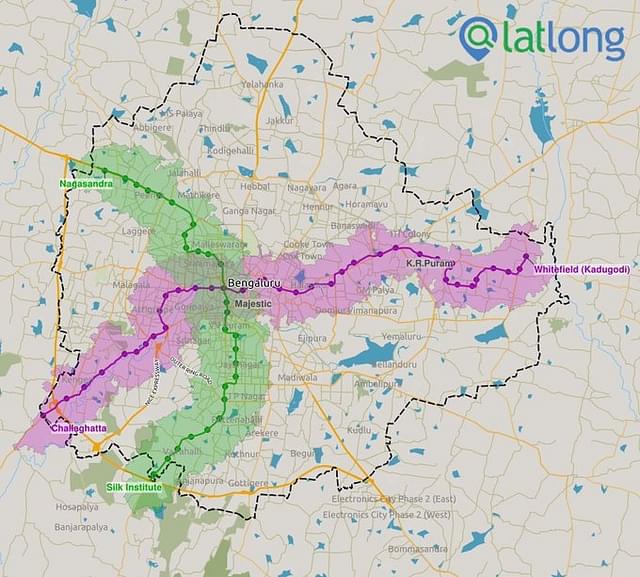
Additionally, 101.5 km is under construction, with a further 79 km planned, including — 43 km under Phase 3A and 36 km under Phase 3B. Upon completion, Bengaluru will have a metro network of 255 km.
Further in the progress, the Yellow Line of Phase-2 metro project is expected for 2024 completion, link R V Road to Bommasandra — a fast-growing suburb on the outskirts of Bengaluru.
The 19-km long new route will cover Jayadeva, Central Silk Board, and Electronics City, facilitating commuting for businesses within the E-City corridor. Once finished, about half of BBMP’s population will live within 3 km of a metro station.
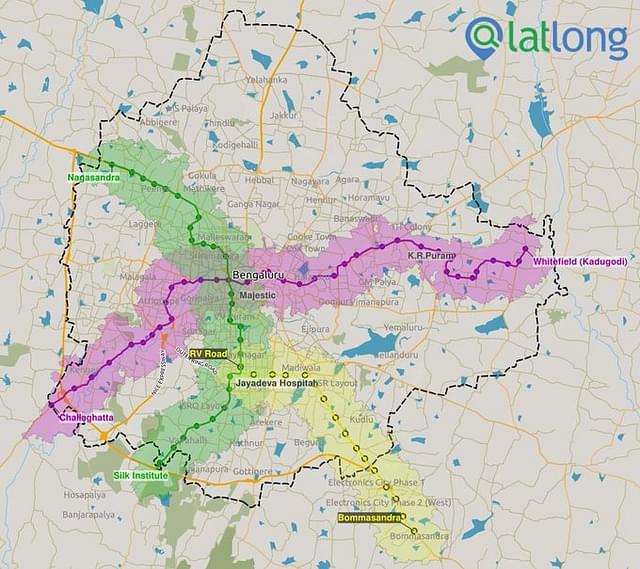
Over the next few years, the under-construction pink and blue lines, along the yellow, purple, and green lines, will extend the network to all significant city edges, bringing close to 70 per cent of BBMP population within 3 km of a metro station.
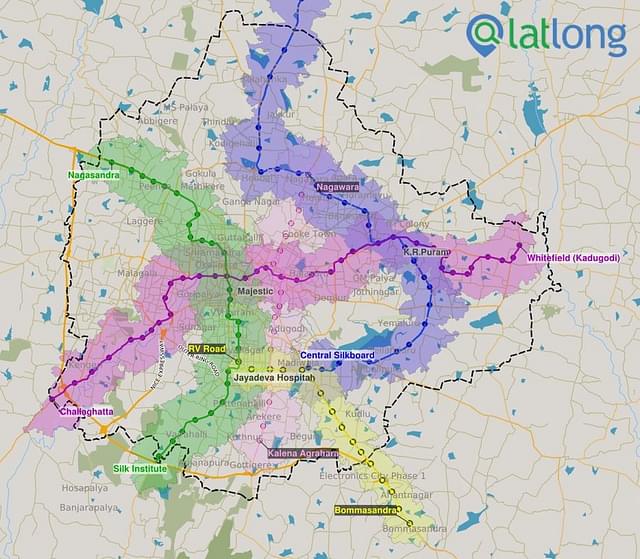
As this network extends across a city plagued with persistent traffic issues, while it continues to grow, efforts for last mile connectivity and development initiatives along the corridors become crucial, to align with the transit network’s larger growth objectives.
Increasing Metro Ridership Relies Heavily On Efficient Last-Mile Connectivity
As the Bengaluru metro system aims to improve public transportation by offering faster and more reliable commuting options, increasing metro ridership relies heavily on improving last-mile connectivity — to encourage more people to choose the metro over private cars.
While some feeder services currently exist, they are limited in their coverage.
A recent survey, conducted jointly by the Bangalore Political Action Committee (B.PAC) and World Resource Institute India (WRI), delved into commuter travel habits in Bengaluru to pinpoint gaps in accessing public transportation.
The findings indicated that 95 per cent of those currently using private vehicles would switch to the metro, if the first and last mile connections were seamless. It also covered areas like Whitefield, Mahadevapura, and ORR — home to about 100,000 employees to be served by new metro lines.
It revealed that 95 per cent respondents, who are currently using private vehicles to reach their offices, are willing to shift to metro in Bengaluru, provided there is seamless first and last mile connectivity.
Out of 3,855 respondents, the majority cent relied on personal vehicles daily and spent roughly 1.5 hours one way, while existing metro users spent 45 minutes to an hour when commuting to these areas.
Further, 62 per cent of current public transport users sought improved footpaths, and 33 per cent desired increased bus frequency. Among women respondents, 40 per cent identified key challenges such as the lack of reliable first and last mile services.
Both current and potential public transport users suggested that improving this connectivity, with seamless multi-modal integration, would incentivise the use of public transportation.
For improving such connectivity challenges, it requires a shift toward data-driven initiatives instead of relying on intuition or bus numbers.
Srinivas Alavilli, Fellow, WRI India, states, “For efficient public transport in the city, the three crucial elements remain — availability, reliability and accessibility.”
With the metro’s availability and reliability now, ensuring accessibility for the first and last mile remains a priority and needs to be actively addressed.
Srinivas is involved on a project called ‘Personal2Public’, which aims at creating a public transit ecosystem to encourage a shift from private to public transportation.
Speaking with Swarajya, Srinivas adds, “With the opening of the metro to Whitefield, more than a lakh people make use of the metro route, and close to 15,000 people are using the feeder buses. This is an encouraging shift in the culture of the public transit of the city.
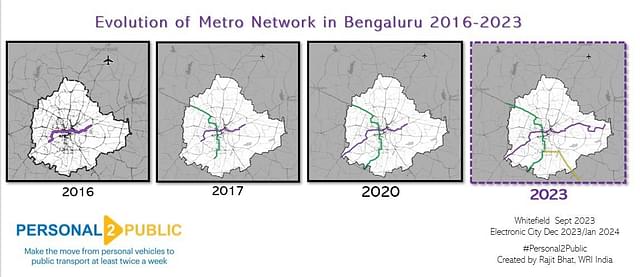
“To further enhance this accessibility, multiple projects are underway with the government, including increasing number of feeder buses from 100 to 300, while also enhancing footpaths and walking infrastructure, to ease first and last mile connectivity.”
Some of the initiatives by government focusing on last-mile connections include the Metro Mitra app, recently launched for Bengaluru’s metro users.
Despite autorickshaws being prevalent, lack of a regulated pricing system has kept the city’s growing reliance on private vehicles. To address this, the app ensures adherence to regulated fares. However, its impact on reversing the decline in usage remains uncertain.
To increment the services, apart from large feeder buses, authorities also need to push for smaller, more frequent vehicles that could encourage metro adoption.
For such cases, new mobility enterprises are providing innovative on-demand services, especially in areas with higher-income residents, with use of clean fuels and EVs for sustainable and cost-effective last-mile connectivity.
While official efforts for metro connectivity are ongoing, citizen initiatives are also emerging to simplify commuting.
Bengaluru residents are exploring foldable bicycles as an alternative for travelling to and from the metro, carrying cycles in the metro. Individual initiatives like these, are also advocating the idea of a metro-bicycle-friendly infrastructure, emphasising a blend of public transport and cycling convenience.
Metro Infrastructure Further Stimulates Economic Avenues Along Its Expanse
While connectivity options acts as the support system for increased usage, the metro infrastructure also stimulates economic opportunities along its expanse.
Built on the premise that urban transport, land use and economic growth, can be managed more efficiently if planned together, Indian cities have a huge potential to implement transit-oriented development — to enhance living conditions and elevate the areas along the metro corridor into investment hubs.
From its various definitions and regional adaptations, TOD involves creating medium-to-high density developments supporting a balanced mix of land use along the corridor. Further, it is about ensuring that populations have easy access to the transit network.
The development approach can achieve a range of objectives, to increase viability of public transport and maximising the use of existing infrastructure.
In May 2017, the Ministry of Housing and Urban Affairs (MoHUA) introduced the National Transit Oriented Development policy, serving as a guiding framework for states and cities adopting transit-oriented development (TOD) as a strategy for urban growth.
As per earlier reports, Anjum Parvez, the managing director, BMRCL, said in a statement, that the TOD policy will be implemented on a pilot basis in six metro stations in Bengaluru.
The TOD policy 2022 for Bengaluru by Directorate of Urban Land Transport defines three influence zones including — the core zone, situated within a 500 m walkshed of a station, a standard zone spanning from 500 m to 1 km, reachable by cycling, and larger catchment areas up to 2 km served by feeder services.
As per experts, the pilot project, being implemented in Phases 2A and 2B of Bengaluru’s metro network marks the first instance of integrating such planning initiatives within the metro system in the city.
The initiative is expected to further help develop methodology for application to similar zones citywide.
Moreover, this extensive network will bring significant benefits to the ambitious economic growth targets, as it unlocks immense potential for the regions surrounding these transit networks.
With these considerations, the city authorities should focus on bringing a better relationship between the metro network and development oriented around it — to leverage the influence of these advanced transportation facilities.


